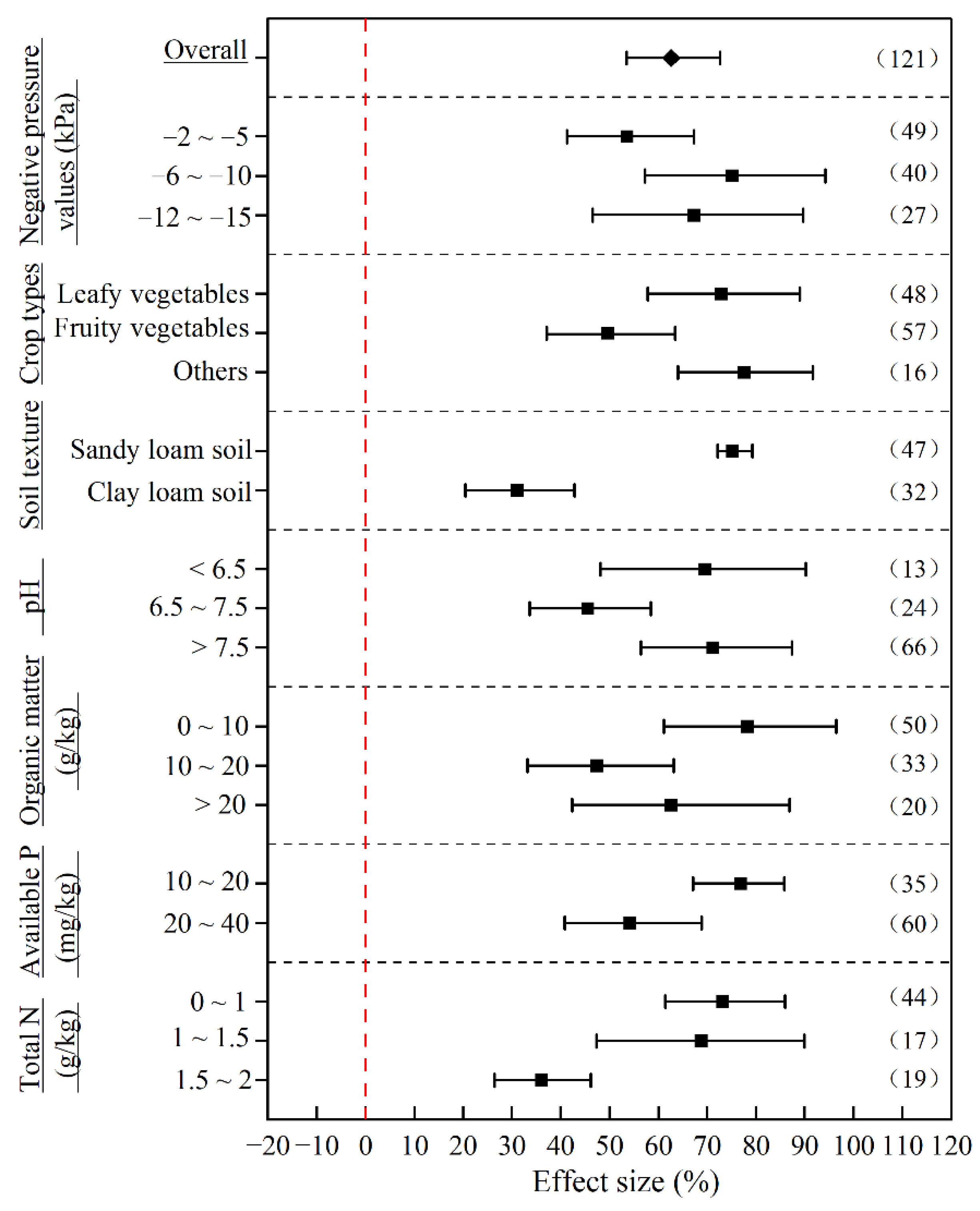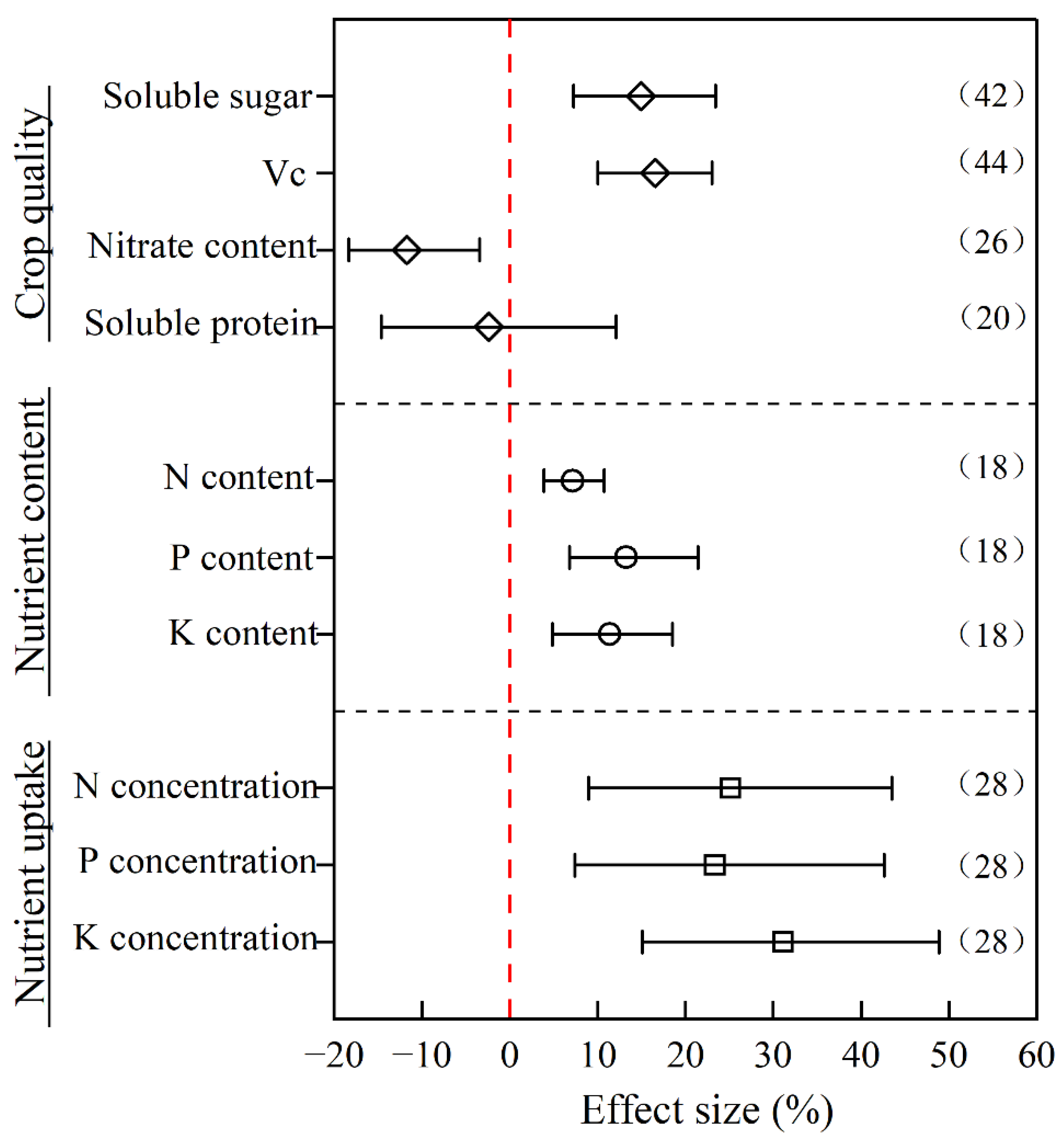Comprehensive Assessment of Plant and Water Productivity Responses in Negative Pressure Irrigation Technology: A Meta-Analysis
Abstract
:1. Introduction
2. Materials and Methods
2.1. Data Collection
2.2. Data Analysis
2.3. Data Calculation
3. Results
3.1. Effect Size on Crop Yield under NPI
3.2. Effect Size on Water Use Efficiency under NPI
3.3. Crop Quality and Nutrient Uptake on NPI
3.4. Analysis of Factors Influencing Yield under NPI and CI
4. Discussion
4.1. NPI Improves Crop Yields and WUEs
4.2. NPI Benefits Crop Quality and Nutrient Uptake
4.3. Fertilizer Savings under NPI Conditions
5. Conclusions
Author Contributions
Funding
Institutional Review Board Statement
Informed Consent Statement
Data Availability Statement
Conflicts of Interest
References
- Kadiresan, K.; Khanal, P. Rethinking irrigation for global food security. Irrig. Drain. 2018, 67, 8–11. [Google Scholar] [CrossRef]
- Peng, Y.; Xiao, Y.; Fu, Z.; Dong, Y.; Zheng, Y.; Yan, H.; Li, X. Precision irrigation perspectives on the sustainable water-saving of field crop production in China: Water demand prediction and irrigation scheme optimization. J. Clean. Prod. 2019, 230, 365–377. [Google Scholar] [CrossRef]
- Long, H.; Wu, X.; Zhang, S.; Wang, J.; Drohan, P.J.; Zhang, R. Connotation and research progress of crop initiate water drawing technology. Trans. Chin. Soc. Agric. Eng. 2020, 36, 139–152. (In Chinese) [Google Scholar]
- Fan, Z.; Lin, S.; Zhang, X.; Jiang, Z.; Yang, K.; Jian, D.; Chen, Y.; Li, J.; Chen, Q.; Wang, J. Conventional flooding irrigation causes an overuse of nitrogen fertilizer and low nitrogen use efficiency in intensively used solar greenhouse vegetable production. Agric. Water Manag. 2014, 144, 11–19. [Google Scholar] [CrossRef]
- Long, H.; Zhang, H.; Yue, X.; Zhang, R. Design and experiment of heavy-type negative pressure value used for negative pressure irrigation. Trans. Chin. Soc. Agric. Eng. 2018, 34, 85–92. (In Chinese) [Google Scholar]
- Michael, O.; David, O.; Frederick, A.; Paul, A.; Kwame, A. Meta-analysis of crop yields of full, deficit, and partial root-zone drying irrigation. Agric. Water Manag. 2018, 197, 79–90. [Google Scholar] [CrossRef]
- Lv, H.; Lin, S.; Wang, Y.; Lian, X.; Zhao, Y.; Li, Y.; Du, J.; Wang, Z.; Wang, J.; Butterbach-Bahl, K. Drip fertigation significantly reduces nitrogen leaching in solar greenhouse vegetable productions system. Environ. Pollut. 2019, 245, 694–701. [Google Scholar] [CrossRef]
- Yang, P.; Bai, J.; Yang, M.; Ma, E.; Yan, M.; Long, H.; Liu, J.; Li, L. Negative pressure irrigation for greenhouse crops in China: A review. Agric. Water Manag. 2022, 164, 107497. [Google Scholar] [CrossRef]
- Zhao, X.; Gao, X.; Zhang, S.; Long, H. Improving the growth of rapeseed (Brassica chinensis L.) and the composition of rhizosphere bacterial communities through negative pressure irrigation. Water Air Soil Poll. 2019, 239, 9. [Google Scholar] [CrossRef]
- Moniruzzaman, S.; Fukuhara, T.; Terasaki, H. Experimental study on water balance in a negative pressure difference irrigation system. J. Jpn. Soc. Civ. Eng. 2011, 67, 103–108. [Google Scholar] [CrossRef]
- Zhang, J.; Ji, J.; Wang, P.; Long, H.; Wu, X. Molecular mechanism of negative pressure irrigation inhibiting root growth and improving water use efficiency in maize. Plant Soil 2021, 472, 127–143. [Google Scholar] [CrossRef]
- Zhang, J.; Wang, P.; Ji, J.; Long, H.; Wu, X. Transcriptome analysis reveals molecular mechanism of yield increases in maize under stable soil water supply. PLoS ONE 2021, 9, e0257756. [Google Scholar] [CrossRef]
- Iwama, H.; Kubota, T.; Ushiroda, T.; Osazawa, S.; Katou, H. Control of soil water potential using negative pressure water circulation technique. Soil Sci. Plant Nutr. 1991, 37, 7–14. [Google Scholar] [CrossRef]
- Bian, Y.; Yang, P.; Long, H.; Ding, Y.H.; Li, D. Water use efficiency and nutrient absorption of spinach (Spinacia oleracea L.) under two material emitters and negative water supply pressure. J. Plant Nutr. Fert. 2018, 24, 507–518. (In Chinese) [Google Scholar]
- Gao, X.; Zhang, S.; Zhao, X.; Long, H. Stable water and fertilizer supply by negative pressure irrigation improve tomato production and soil bacterial communities. SN Appl. Sci. 2019, 1, 178. [Google Scholar] [CrossRef]
- Li, Y.; Xue, X.; Guo, W.; Wang, L.; Duan, M.; Chen, H.; Chen, F. Soil moisture and nitrate-nitrogen dynamics and economic yield in the greenhouse cultivation of tomato and cucumber under negative pressure irrigation in the North China Plain. Sci. Rep. 2019, 9, 4439. [Google Scholar] [CrossRef] [PubMed]
- Song, Y.; Zhao, X.; Zhang, S. Reducing nitrogen input and improving yield and quality of rape through combination of fertigation and nitrification/urease inhibitor addition. J. Plant Nut. Fertil. 2017, 23, 632–640. (In Chinese) [Google Scholar]
- Lipiec, J.; Kubota, T.; Iwama, H.; Hirose, J. Measurement of plant water use under controlled soil moisture conditions by the negative pressure water circulation technique. Soil Sci. Plant Nutr. 1998, 34, 417–428. [Google Scholar] [CrossRef]
- Zhang, Z.; Liu, S.; Jia, S.; Du, F.; Qi, H.; Li, J.; Song, X.; Zhao, N.; Nie, L.; Fan, F. Precise soil water control using a negative pressure irrigation system to improve the water productivity of greenhouse watermelon. Agric. Water Manag. 2021, 263, 107144. [Google Scholar] [CrossRef]
- Ding, Y.; Xiao, H.; Wang, D. Effect of potassium fertigation on potassium absorption and growth of flue-cured tobacco. J. Plant Nutr. Fertil. 2017, 23, 1238–1248. (In Chinese) [Google Scholar]
- Gao, X.; Zhang, S.; Zhao, X.; Long, H. Evaluation of potassium application on tomato performance and rhizosphere bacterial communities under negative pressure irrigation of greenhouse-grown. J. Plant Nutr. 2020, 43, 317–326. [Google Scholar] [CrossRef]
- Wang, J.; Huang, Y.; Long, Y.; Hou, S.; Xiang, A.; Sun, Z. Simulations of water movement and solute transport through different soil texture configurations under negative-pressure irrigation. Hydrol. Process. 2017, 31, 2599–2612. [Google Scholar] [CrossRef]
- Li, S.; Tan, D.; Wu, X.; Degre, A.; Long, H.; Zhang, S.; Lu, J.; Gao, L.; Zheng, F.; Liu, X.; et al. Negative pressure irrigation increases vegetable water productivity and nitrogen use efficiency by improving soil water and NO3−-N distributions. Agric. Water Manag. 2021, 251, 106853. [Google Scholar] [CrossRef]
- Li, D.; Long, H.Y.; Zhang, S.X.; Wu, X.P.; Shao, H.Y.; Wang, P. Effect of continuous negative pressure water supply on the growth, development and physiological mechanism of Capsicum annuum L. J. Integr. Agric. 2017, 16, 1978–1989. [Google Scholar] [CrossRef]
- Gao, X.; Zhang, S.; Song, Y.; Long, H. Negative pressure irrigation system reduces soil nitrogen loss for lettuce during greenhouse production. Agronomy 2021, 11, 2380. [Google Scholar] [CrossRef]
- Zhang, J.; Wang, P.; Long, H.; Su, S.; Wu, Y.; Wang, H. Metabolomics analysis reveals the physiological mechanism underlying growth restriction in maize roots under continuous negative pressure and stable water supply. Agric. Water Manag. 2022, 263, 107452. [Google Scholar] [CrossRef]
- Schutz, L.; Gattinger, A.; Meier, M.; Muller, A.; Boller, T.; Mader, P.; Mathimaran, N. Improving crop yield and nutrient use efficiency via biofertilization—A global meta-analysis. Front. Plant Sci. 2018, 8, 2204. [Google Scholar] [CrossRef]
- Xiang, Y.; Huang, Y.; Huang, C.; Long, H. Influence of different water supply negative pressures on the growth and main physiological indexes of Chinese cabbage. J. Agric. Sci. Technol. 2019, 20, 16–22. (In Chinese) [Google Scholar]
- Li, S.; Wu, X.; Dang, J.; Pei, X.; Gao, L.; Li, J.; Wang, B.; Liang, G.; Long, H. Effects of negative pressure irrigation on yield, quality and water and nitrogen use efficiency of cucumber. Soils Fertil. Sci China 2017, 2, 55–62. (In Chinese) [Google Scholar]
- Wang, C.; Gu, F.; Chen, J.; Yang, H.; Jiang, J.; Du, T.; Zhang, J. Assessing the response of yield and comprehensive fruit quality of tomato grown in greenhouse to deficit irrigation and nitrogen application strategies. Agric. Water Manag. 2015, 161, 9–19. [Google Scholar] [CrossRef]
- Xiang, Y.; Huang, Y.; Long, H.; Long, Q.; Zhang, Y. Effects of different negative pressures on the growth and water use efficiency of pepper plants. Res. Agric. Mod. 2019, 40, 161–168. (In Chinese) [Google Scholar]
- Wang, J.; Huang, Y.; Long, H. Water and salt movement in different soil textures under various negative irrigation pressures. J. Integr. Agric. 2016, 15, 1874–1882. [Google Scholar] [CrossRef]
- Ma, Y.; Ren, X.; Yang, S.; Zong, J.; Sun, H.; Lv, M.; Wu, D. Effect of fertigation by keeping irrigating water under negative pressure on quality and yield of pepper grown in greenhouse. J. Irrig. Drain. 2017, 36, 17–20. [Google Scholar]
- Jiang, P.; Lei, T.; Bralts, V. Effects of soil textures and emitter material on the soil water movement and efficiency of negatively pressurized irrigation system. Trans. Chin. Soc. Agric. Eng. 2006, 22, 19–22. (In Chinese) [Google Scholar]
- Wang, J.; Long, H.; Huang, Y.; Wang, X.; Cai, B.; Liu, W. Effects of different irrigation management parameters on cumulative water supply under negative pressure irrigation. Agric. Water Manag. 2019, 224, 105743. [Google Scholar] [CrossRef]
- Singandupe, B.; Rao, G.; Patil, G.; Brahmanand, P. Fertigation studies and irrigation scheduling in drip irrigation system in tomoto crop (Lycopersicon esculentum L.). Eur. J. Agron. 2003, 19, 327–340. [Google Scholar] [CrossRef]
- Zhao, X.; Song, Y.; Yue, X. Effect of different potassium levels on the growth of bok choy under negative pressure. Sci. Agric. Sin. 2017, 50, 689–697. (In Chinese) [Google Scholar]
- Adiku, K.; Renger, M.; Wessolek, G.; Facklam, M.; Hecht-Bucholtz, C. Simulation of the dry matter production and seed yield of common beans under varying soil water and salinity conditions. Agric. Water Manag. 2001, 47, 55–68. [Google Scholar] [CrossRef]
- Patane, C.; Tringali, S.; Sortino, O. Effects of soil water on yield and quality of processing tomato under a Mediterranean climate conditions. Agric. Water Manag. 2010, 97, 131–138. [Google Scholar] [CrossRef]
- Xiao, H.; Ding, Y.; Huang, C.; Yang, H.; Guan, E.; Gao, K.; Long, H. Effect of negative pressure irrigation on water fertilizer utilization and flue-cured tobacco growth. Acta Tab. Sin. 2016, 22, 52–60. (In Chinese) [Google Scholar]
- Guo, Y.; Chen, Y.; Searchinger, T.; Zhou, M.; Pan, D.; Yang, J.; Wu, L.; Cui, Z.; Zhang, W.; Zhang, F.; et al. Air quality, nitrogen use efficiency and food security in China are improved by cost-effective agricultural nitrogen management. Nat. Food 2020, 1, 648–658. [Google Scholar] [CrossRef]
- Wang, X.; Dou, Z.; Shi, X.; Zou, C.; Liu, D.; Wang, Z. Innovative management programme reduces environmental impacts in Chinese vegetable production. Nat. Food 2021, 2, 47–53. [Google Scholar] [CrossRef]
- Subbarao, G.V.; Searchinger, T.D. A “more ammonium solution” to mitigate nitrogen pollution and boost crop yields. Proc. Natl. Acad. Sci. USA 2021, 118, e2107576118. [Google Scholar] [CrossRef] [PubMed]
- Subbarao, G.V.; Kishii, M.; Bozal-Leorri, A.; Ortiz-Monasterio, I.; Gao, X.; Ibba, M.I.; Karwat, H.; Gonzalez-Moro, M.B.; Gonzalez-Murua, C.; Yoshihashi, T.; et al. Enlisting wild grass genes to combat nitrification in wheat farming: A nature-based solution. Proc. Natl. Acad. Sci. USA 2021, 118, e2106595118. [Google Scholar] [CrossRef] [PubMed]





| Sample Size (n) | Z Value | p Value | |
|---|---|---|---|
| Crop yields | 135 | 0.5472 | 0.5842 |
| Water use efficiencies | 113 | −0.1597 | 0.8731 |
| Crop quality | 132 | 0.7764 | 0.4375 |
| Nutrient content | 54 | 1.7533 | 0.0796 |
| Nutrient concentration | 63 | −0.9302 | 0.3523 |
Publisher’s Note: MDPI stays neutral with regard to jurisdictional claims in published maps and institutional affiliations. |
© 2022 by the authors. Licensee MDPI, Basel, Switzerland. This article is an open access article distributed under the terms and conditions of the Creative Commons Attribution (CC BY) license (https://creativecommons.org/licenses/by/4.0/).
Share and Cite
Jin, Y.; Gao, X.; Zhang, R.; Wu, X.; Long, H.; Sun, Z.; Zhang, S. Comprehensive Assessment of Plant and Water Productivity Responses in Negative Pressure Irrigation Technology: A Meta-Analysis. Agronomy 2022, 12, 1925. https://doi.org/10.3390/agronomy12081925
Jin Y, Gao X, Zhang R, Wu X, Long H, Sun Z, Zhang S. Comprehensive Assessment of Plant and Water Productivity Responses in Negative Pressure Irrigation Technology: A Meta-Analysis. Agronomy. 2022; 12(8):1925. https://doi.org/10.3390/agronomy12081925
Chicago/Turabian StyleJin, Yuwen, Xiang Gao, Renlian Zhang, Xueping Wu, Huaiyu Long, Zhimei Sun, and Shuxiang Zhang. 2022. "Comprehensive Assessment of Plant and Water Productivity Responses in Negative Pressure Irrigation Technology: A Meta-Analysis" Agronomy 12, no. 8: 1925. https://doi.org/10.3390/agronomy12081925






